
AURORA HORSE SHOW 1923 – 2006
The
LAND ACKNOWLEDGMENT
We acknowledge that in Aurora we are on the traditional and treaty territory of the Chippewas of Georgina Island, who are Anishinaabe peoples, and one of the First Nations reserves in Ontario. We are grateful to them for sharing their lands with us.
1 • INCEPTION AND THE EARLY YEARS 2 • A False Start 4 • Time to Organize 6 • The First Aurora Horse and Pure Bred Stock Show 9 • Anatomy of a Horse Show 14 • AN AURORA TRADITION IS BORN 15 • Name Changes Through the Years 16 • The Aurora Horse Show Hits its Stride! 22 • L adies Section 26 • A Necessary Hiatus 27 • Popular Classes of Horses 34 • BACK IN THE SADDLE 40 • The Mutt Show 42 • An Olympic Homecoming 44 • A New Stomping Ground 47 • Show Jumping and Dressage 50 • CHANGING WITH THE TIMES 52 • The Trillium Circuit 53 • Baby Contest 55 • Children’s Competitions 57 • Miniature Horse Show 58 • Mounted Sack Race 59 • Anatomy of a Fair 62 • FAREWELL TO THE FAIR & HORSE SHOW 62 • Bye-Bye Bingo 64 • The Last Aurora Fair & Horse Show 67 • One Final Trillium Bloom? 68 • C ome Again Some Other Day 69 • MEMORIES 70 • Deborah Campo 74 • Sylvia Gilchrist 78 • David Heard
Contents

INCEPTION and the EARLY YEARS
Over the past century, there have been conflicting stories about when the Aurora Horse Show officially began. Some authorities have recalled the first show as taking place at various events throughout 1920 – 1923. The confusion over when the horse show truly started requires a closer look at events that took place and were misidentified as the first Aurora Horse Show.
ONE • 1
Aurora Horse Show, Machell Park, 1977 Aurora Museum & Archives (2021.6)
A False Start
The Dominion Day celebrations that were planned for July 1st, 1922, were much like the previous year’s, focused on team sports, footraces, live music (there was scarcely any other kind), and Aemilius Jarvis’ horse-jumping show. Jarvis, one of Canada’s wealthiest men, had made Aurora his home about a decade earlier, and proudly operated the stud farm Hazelburn as a destination for informal jumping competitions and hunting. His jumping show at the 1921 Dominion Day celebrations in Aurora had proven quite popular and the encore promised to be an exciting part of the 1922 event.
These planned events have led some to cite the 1922 Dominion Day Celebrations as the first Aurora Horse Show. However, on the morning of July 1, 1922, Aurorans awoke to heavy rain that lasted until midday, forcing a compressed program of events to take place. The report printed in the next issue of the local paper made much of the baseball and lacrosse matches – the local teams dominated – but no mention was made of Jarvis’ jumpers, something that is hard to understand given the promotion it received. Considering the weather conditions, it’s likely that horse jumping wasn’t included in the modified program of events, prompting the question: were there any horses putting on a show in Town Park on July 1, 1922? We can’t say for certain.
2 • TWO
Notice promoting Dominion Day Events
Aurora Banner, June 23, 1922
Notice for 1922 Dominion Day and Field Day Program of Events

Aurora Banner, May 19, 1922

Re-cap of 1922 Dominion Day Festivities
Aurora Banner, July 7, 1922
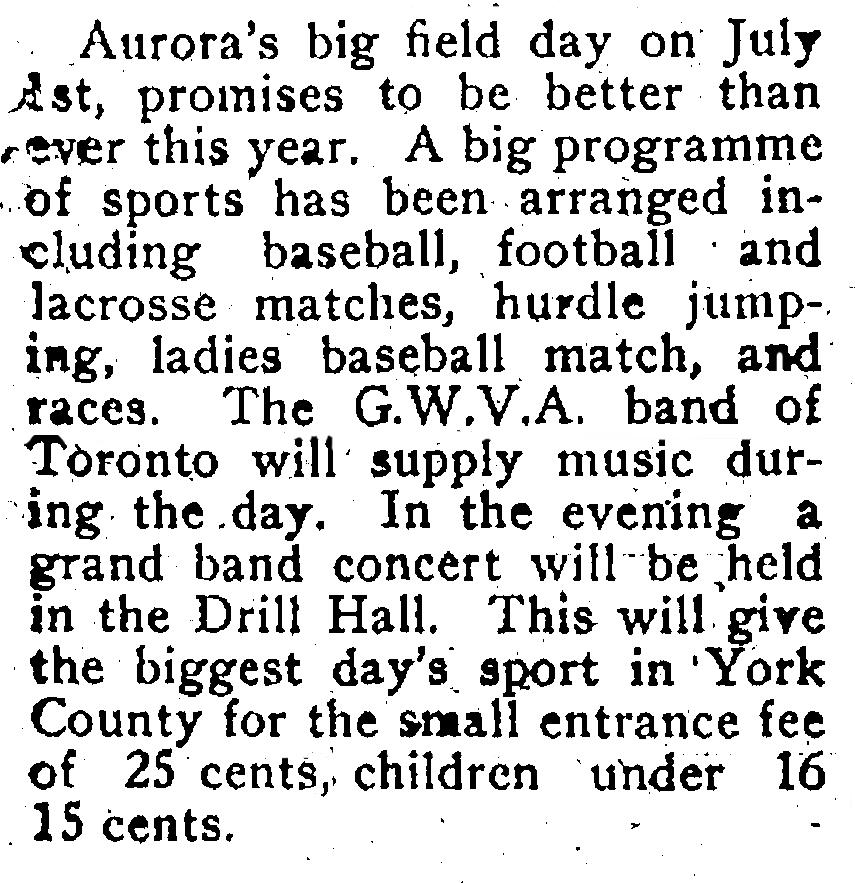
THREE • 3
Time to Organize
In December of 1922, a group of agricultural enthusiasts came together and proposed that a formal spring fair take place that would showcase the district’s livestock, fancy stock, poultry, seed, grain, and feature a premier competitive horse show.
This group would evolve to become the Aurora Agricultural Society. In the January 5, 1923, issue of the Aurora Banner, it was announced that a meeting was being held to plan the spring fair and subsequent notices were published keeping the public informed of the planning status and event details.
Over the next couple of months, the event was referred to as a spring fair, pure bred and livestock show, and eventually, it became known as the Aurora Horse and Pure Bred Stock Show.
One important detail is briefly mentioned in the April 6, 1923, issue of the Aurora Banner when we learn that Mr. Wood, president of the Aurora Agricultural Society, secured Town Park as the venue for the inaugural Horse Show. For more than forty years, Town Park would continue to host thousands of people for the annual event, which quickly became a beloved Aurora tradition.
4 • FOUR
If you were fortunate to own a car, and were driving to Aurora for the 1923 Horse Show, you would encounter a speed sign like this at the southern entrance to town.

Aurora Museum & Archives (2002.19.30)
For those arriving to Aurora on the Radial Railway, this would be the station that would greet them.

Aurora Museum & Archives (78.14.27)
If the Grand Trunk Railway was your preference, you would find yourself arriving here.

Aurora Museum & Archives (2006.7.5)
Notice about organizing a Spring Fair Aurora Banner, December 15, 1922

FIVE • 5
The First Aurora Horse and Pure Bred Stock Show
The inaugural Aurora Horse and Pure Bred Stock Show was held on June 7th, 1923, in Town Park and was hosted by the Aurora Agricultural Society.
The Agricultural Society was tasked with the preparation, fundraising, and organization of the show, as well as deciding which livestock classes and horse events to include and formalizing the rules for judging. In the years that followed the Agricultural Society’s incorporation in 1924, the society became entirely responsible for the operation of the show.
Unlike the celebrations held previous years, the 1923 Aurora Horse and Pure Bred Stock Show was promoted across Southern Ontario, using the official advertisements and programs created by the Aurora Agricultural Society.
Town Park was chosen as the ideal location for the inaugural Aurora Horse and Pure Bred Stock Show, partially due to its long-established role as a community gathering place, but also because it was level ground and already cleared.
The Agricultural Society chose events for the 1923 show that followed a traditional horse and stock show format. The show included a wide assortment of competitively judged equestrian and livestock events, which brought together and highlighted the talents of Aurorans and visitors from across Southern Ontario.
6 • SIX
The 1923 inaugural show was a major success, with more than 2,000 people in attendance. The events program was divided into sections that included light horses, harness horses, draft horses, Clydesdales, and Percherons.
The Pure Bred Stock Show was also divided into sections that included Jerseys, Holsteins, Aberdeen-Angus, Herefords, shorthorns, beef cattle, swine and sheep. After the success of the first show, organizers kept this format throughout the 1920s and into the 1930s.
Program for the inaugural Aurora Horse and Pure Bred Stock Show, 1923


Aurora Museum & Archives (L81.7.24a)
Aurora Museum & Archives (L81.7.24a)
Aurora Agricultural Society Executive, 1923
SEVEN • 7
To compete in either the horse show or the stock show, competitors were required to submit entry forms and pay a one-dollar entry fee. This fee was waived if the competitor showed their proof of membership with the Aurora Agricultural Society. Winners for each competition received either a cash prize, a ribbon, a trophy, or a combination of all three. Aurora Museum & Archives (L81.7.24a)
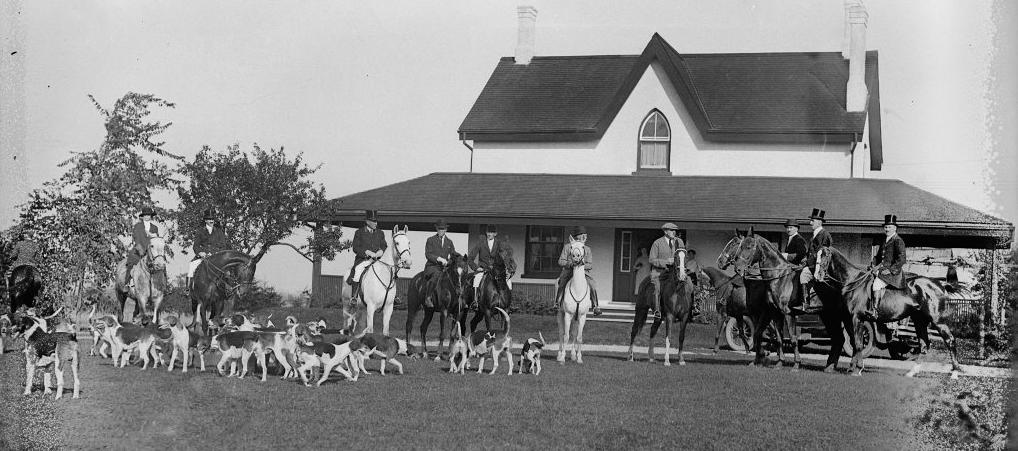
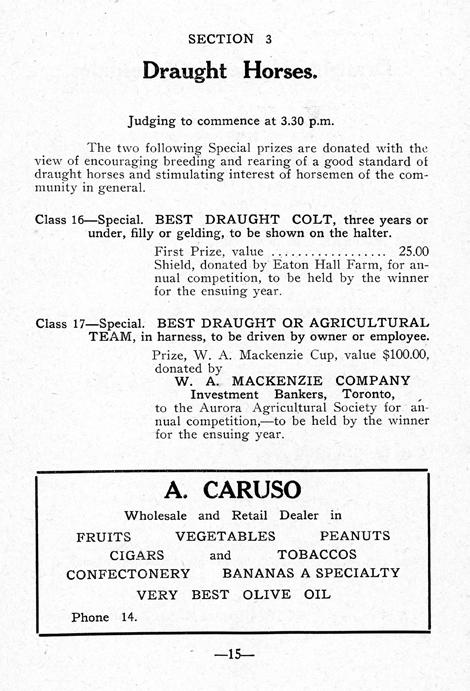
Some competitions were sponsored by area businesses and entrepreneurs, such as Aurora entrepreneur Anthony Caruso Aurora Museum & Archives (L81.7.24a)
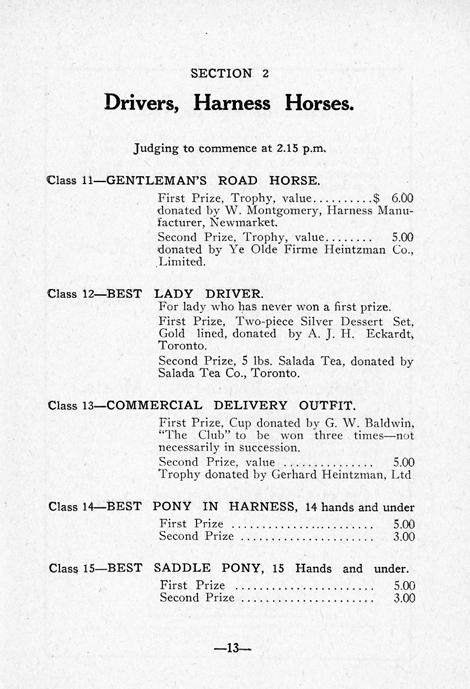 Aemilius Jarvis appears on the 3rd horse from the left, Hazelburn Farm, Aurora, 1923 City of Toronto Archives
Aemilius Jarvis appears on the 3rd horse from the left, Hazelburn Farm, Aurora, 1923 City of Toronto Archives
8 • EIGHT
ANATOMY of a HORSE SHOW
A horse show can include various competitions. The primary contests are: eventing (also known as triathlon competitions) barrel racing, hunt seat, show jumping, and dressage. Each event can then be done in Western or English Style. Each competition is broken down into men’s, women’s, children’s, and youth competitions, all of which were at one time featured at the Aurora Horse Show.

East Ring Timetable of Events, 1934 Aurora Museum & Archives (990.8.28d)

 Aurora Horse Show, 1948
Aurora Museum & Archives (2018.6.5)
Horses lined up for inspection, 1948
Aurora Museum & Archives (2018.6.36)
Aurora Horse Show, 1948
Aurora Museum & Archives (2018.6.5)
Horses lined up for inspection, 1948
Aurora Museum & Archives (2018.6.36)
Schedule of Events, Aurora and District Horse Show, 1963

 Aurora Museum & Archives (81.44.7)
Aurora Horse Show, Town Park, 1950
Gift from the Wallace Family, taken by local photographer G. Barrager, Aurora Museum & Archives (2023.4.6)
Aurora Museum & Archives (81.44.7)
Aurora Horse Show, Town Park, 1950
Gift from the Wallace Family, taken by local photographer G. Barrager, Aurora Museum & Archives (2023.4.6)


 Jumping at the Aurora Horse Show, 1983
Photo Courtesy of John Sanderson
Horses lined up for inspection, 1983
Photo Courtesy of John Sanderson
Aurora Fair and Horse Show, c. 1990-2000
Photo Courtesy of Sylvia Gilchrist
Jumping at the Aurora Horse Show, 1983
Photo Courtesy of John Sanderson
Horses lined up for inspection, 1983
Photo Courtesy of John Sanderson
Aurora Fair and Horse Show, c. 1990-2000
Photo Courtesy of Sylvia Gilchrist
An AURORA TRADITION is BORN
With each passing year, the Aurora Horse and Pure Bred Stock Show became bigger and bigger, and as it did, it began to hold a special place in the hearts of Aurorans. The first thirty years of the event are remembered by many as the cherished formative years that established a beloved tradition.
14 • FOURTEEN
NAME CHANGES THROUGH THE YEARS
1923 to 1932
AURORA HORSE AND PURE-BRED STOCK SHOW
1932 to 1984
AURORA HORSE SHOW, or AURORA AND DISTRICT HORSE SHOW
1985 to 1999
AURORA HORSE SHOW, or THE AURORA FAIR AND HORSE SHOW
2000 to 2006
AURORA AGRICULTURAL SOCIETY FAIR AND HORSE SHOW, or THE AURORA FAIR AND HORSE SHOW
FIFTEEN • 15
The Aurora Horse Show
Hits Its Stride!
Thousands of people from across the region and the province made their way to Aurora every summer to take part in the horse and livestock shows, as well as to experience Aurora’s small-town ambience.
It wasn’t long before the Aurora Horse Show established itself as a permanent fixture in Aurora, and while doing so, it did experience some changes. In the early part of the 1930s, the show’s focus shifted from having equal time devoted to both horse and livestock events, to a focus on just equestrian events with some additional attractions. Livestock events continued to remain a part of the show but were no longer part of its name.

of Events, 1930 Aurora Museum & Archives (990.8.28a) 16 • SIXTEEN
Timetable
Prize List for the Aurora Horse and Pure Bred Stock Show, 1930



Aurora Museum & Archives (990.8.28a)
Prize List, 1935
Aurora Museum & Archives (990.8.28g)
Excerpt from the 1935 Prize List
Aurora Museum & Archives (990.8.28f inside)
SEVENTEEN • 17

 Aurora Horse Show, Town Park, 1948
Aurora Horse Show, Town Park, 1948
18 • EIGHTEEN
Aurora Museum & Archives (2018.6.35)
Aurora Horse Show, Town Park, 1948
Aurora Museum & Archives (2018.6.51)


NINETEEN • 19
Aurora Horse Show, 1948
Aurora Museum & Archives (2018.6.43)
Aurora Horse Show, Town Park, 1948 Aurora Museum & Archives (2018.6.60a)
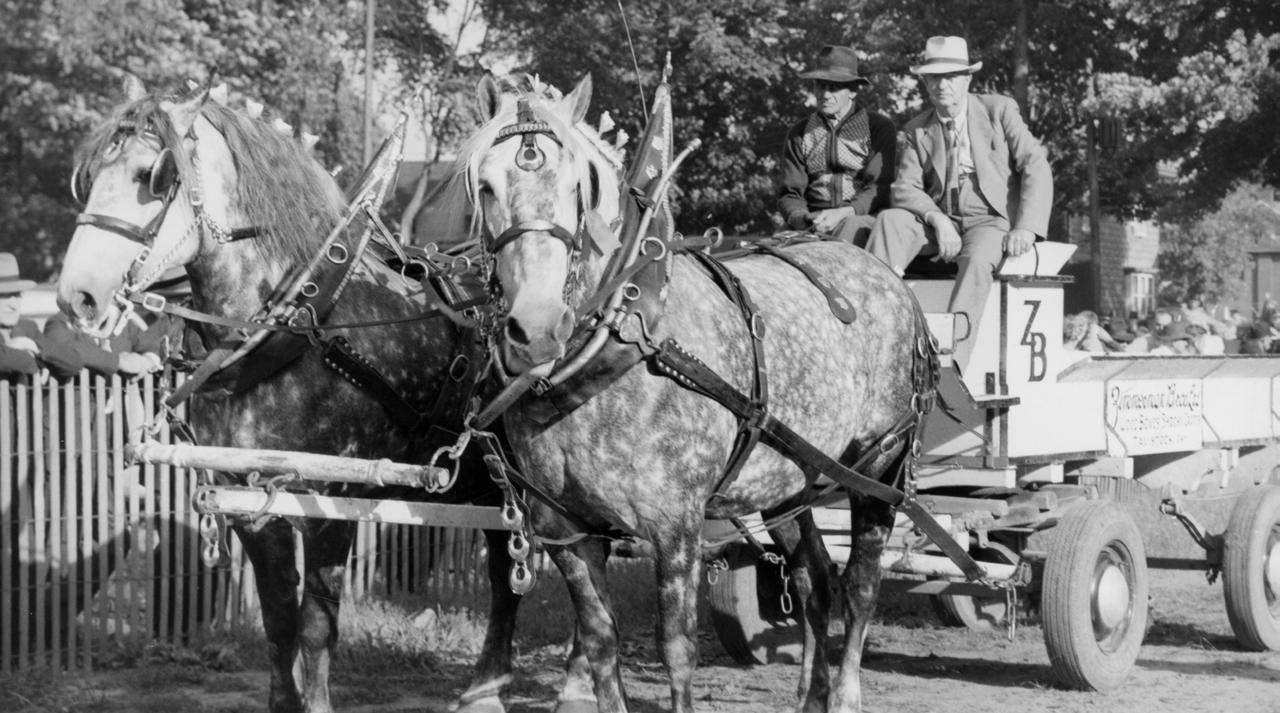

20 • TWENTY
One of the Zimmerman Brothers’ carriage teams at the Aurora Horse Show, 1950 Gift from the Wallace Family, taken by local photographer G. Barrager, Aurora Museum & Archives (2023.4.1)
Aurora Horse Show, 1948 Aurora Museum & Archives (2018.6.31)

 Contestants at the Aurora Horse Show, 1950
Contestants at the Aurora Horse Show, 1950
TWENTY-ONE • 21
Gift from the Wallace Family, taken by local photographer G. Barrager, Aurora Museum & Archives (2023.4.11)
Aurora Horse Show, 1950
Gift from the Wallace Family, taken by local photographer G. Barrager, Aurora Museum & Archives (2023.4.14)
Ladies’ Section
As the show grew and evolved, new attractions became as important and memorable as the horse and livestock competitions. The largest of these new additions was a group of competitions collectively known as the Ladies’ Section.
DOMESTIC DESIGNS
Originally known as the Ladies’ Fancy Work and Domestic Science Section, the section was established by Lorne Evans and added to the program of events in 1935, eventually becoming a permanent attraction at the show for all visitors to enjoy.
The Ladies’ Section was composed of domestic science and home crafts (which included seven varieties of food), needlework/needlecraft, antiques, crafts and hobbies, flowers, women’s organizations, and boys’ and girls’ work. These events were held at various locations over the years, including the Aurora High School on Wells Street and the Armoury in Town Park. During the late 1960s, the Ladies’ Section found its permanent home at the Aurora Community Centre.
Those interested in needlework or needlecraft could enter in sewing, knitting, crochet, needlepoint, household linens, quilting, and rug hooking competitions. For the crafts and hobbies category, entrants could enter in painting, drawing, or flower arranging competitions. Winners in the Ladies’ Section would receive a combination of special trophies, ribbons, and small cash prizes.
22 • TWENTY-TWO


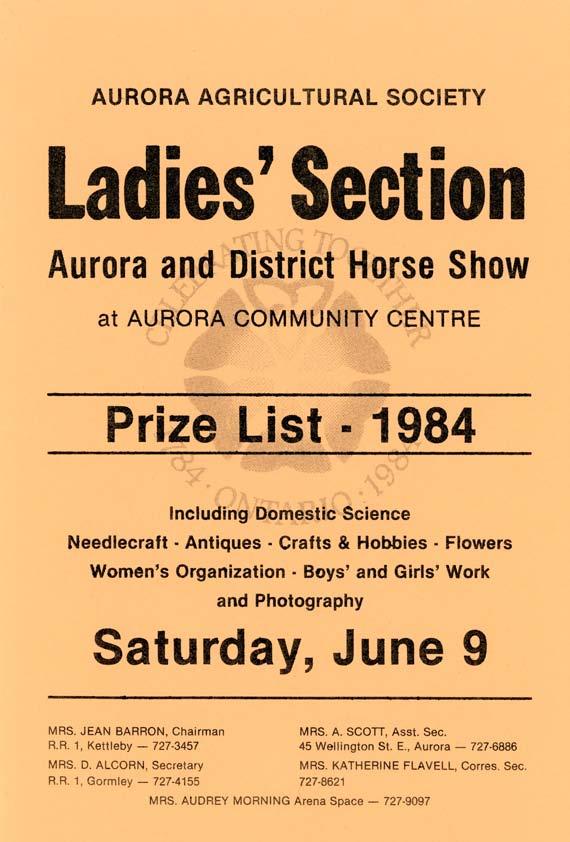

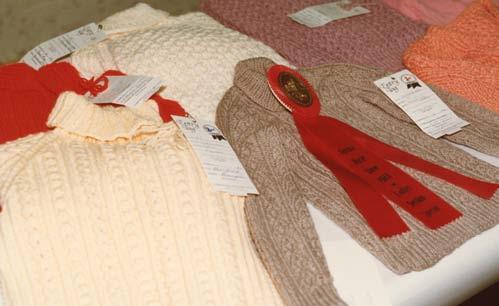 Ladies Section, Aurora Horse Show, c. 1948 Aurora Museum & Archives (2018.6.86b)
Ladies Section, Aurora Horse Show, c. 1948 Aurora Museum & Archives (2018.6.1b)
Ladies’ Section Prize List, 1984
Photo Courtesy of Richard Ruddock
Winning Entries in the Ladies Section, 1984
Photo Courtesy of Richard Ruddock
Flower Specimen Entry, Ladies’ Section, 1984
Ladies Section, Aurora Horse Show, c. 1948 Aurora Museum & Archives (2018.6.86b)
Ladies Section, Aurora Horse Show, c. 1948 Aurora Museum & Archives (2018.6.1b)
Ladies’ Section Prize List, 1984
Photo Courtesy of Richard Ruddock
Winning Entries in the Ladies Section, 1984
Photo Courtesy of Richard Ruddock
Flower Specimen Entry, Ladies’ Section, 1984
TWENTY-THREE • 23
Photo Courtesy of Richard Ruddock
CULINARY CREATIONS
The food competitions were the most widely enjoyed by spectators. These competitions, known as the Domestic Science Competitions before the 1990s, included entries for cookies, cakes, pies, breads, buns, loaves, tarts, brownies, squares, jams, and preserves.
Some of the most popular food competitions were predictably on the sweeter side and were divided into iced chocolate layer cake, decorated and novelty cake, butter tart, and pie categories. As in all the other competitions held as part of the Ladies’ Section, winners of the food competitions, depending on the year, would receive a combination of special trophies, ribbons, and small cash prizes. During the latter 1980s and 1990s, cake and pie auctions were also included.
In the 1990s, certain food contests were sponsored by various food companies, grocery stores and local bakeries. Over the years, sponsors for the food contests included Robin Hood Foods, Crisco, No Frills, Elize Fine Cakes and Pastries, Sweet Adeline’s Country Kitchen, Hurst Bakery, and the Aurora IGA. In addition to these companies, the food contests were also sponsored by local townspeople.
 First Place Winner in the Chocolate Chip Category of the Food Competition, Sponsored by Robin Hood, 1987
First Place Winner in the Chocolate Chip Category of the Food Competition, Sponsored by Robin Hood, 1987
24 • TWENTY-FOUR
Photo Courtesy of Richard Ruddock
Cake Decorating Contest & Auction Flyer, 1989

Food Contest Entries Aurora Fair and Horse Show, c. 1948
Aurora Museum & Archives (2018.6.87)
 Photo Courtesy of Richard Ruddock
Photo Courtesy of Richard Ruddock
TWENTY-FIVE • 25
A Necessary Hiatus
The Aurora Horse Show was held every summer during the first week of June from 1923 to 1940. This unfortunately changed in 1941, when the show was scaled back due to wartime austerity measures. The show’s usual large-scale format was reduced to a small show with no cash prizes that year. On July 1st, 1942, a carnival was held in its place and in 1943, the show was officially cancelled. Although there was no show in 1943, the Aurora Agricultural Society, in conjunction with the Newmarket Lions Club, hosted a Barn Dance for residents that year. The Aurora Horse Show remained officially on hiatus until the war ended in 1945.


Prize List, 1941 Aurora Museum & Archives (990.8.28m) VE Day Celebrations marking the end of the Second World War in Europe, Aurora, Town Park, May 7, 1945 Aurora Museum & Archives (2005.2.20) 26 • TWENTY-SIX
POPULAR CLASSES of HORSES
HEAVY HORSE • LIGHT HORSE • PONY
HEAVY HORSE COMPETITIONS
A heavy horse, or draft horse, is the largest classification of horse breed and is typically used and bred for farm labour, such as plowing. Examples of heavy horse breeds include Clydesdale, Shire, Percheron, and Belgian. These breeds compete in both riding and pulling competitions. In pulling competitions, the rider is replaced by a driver for a team of heavy horses or a single heavy horse.
 Clydesdale, Heavy Horse Show Contestant, Aurora Horse Show, c. 1948 Aurora Museum & Archives (2018.6.46)
Clydesdale, Heavy Horse Show Contestant, Aurora Horse Show, c. 1948 Aurora Museum & Archives (2018.6.46)
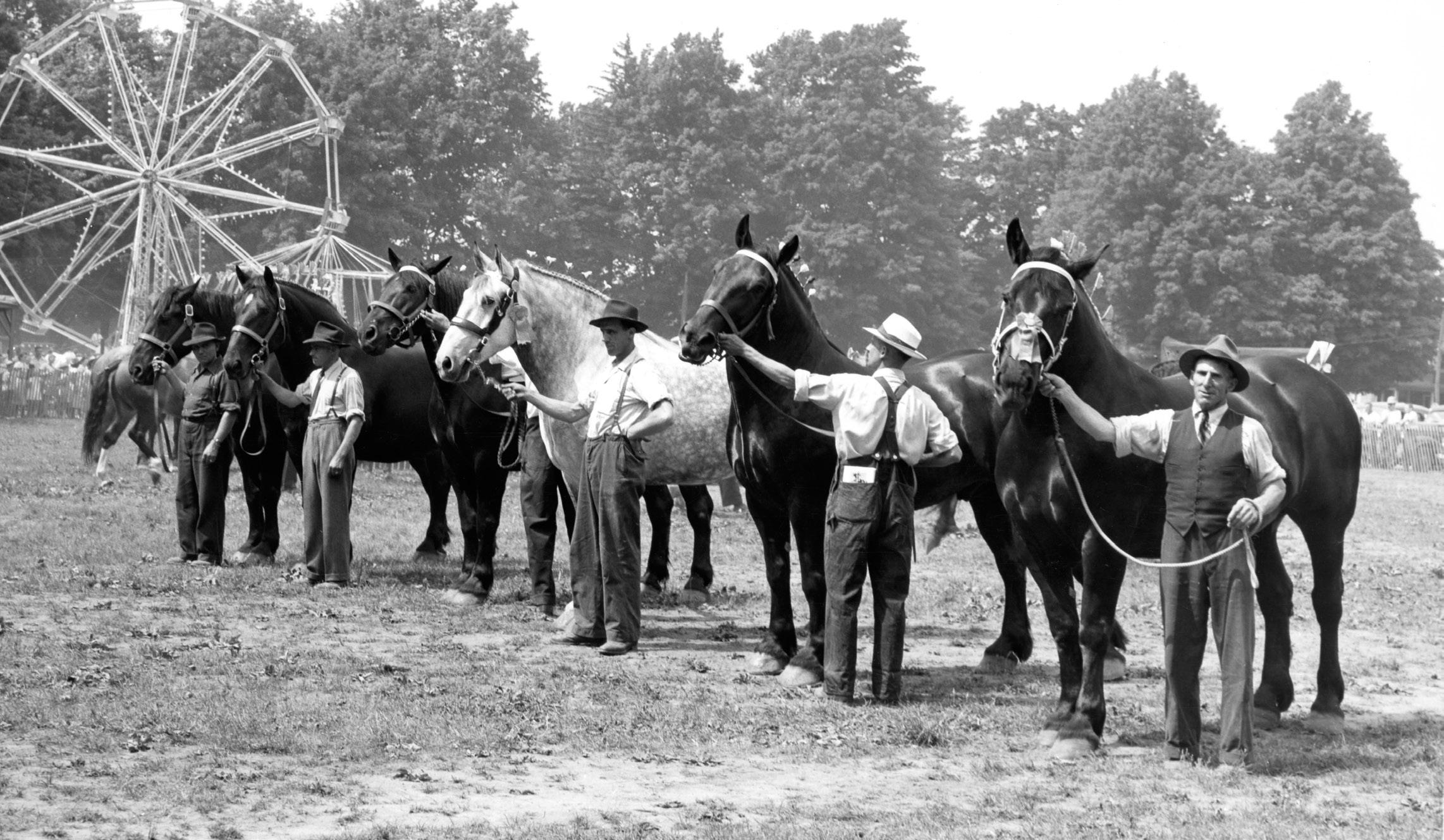
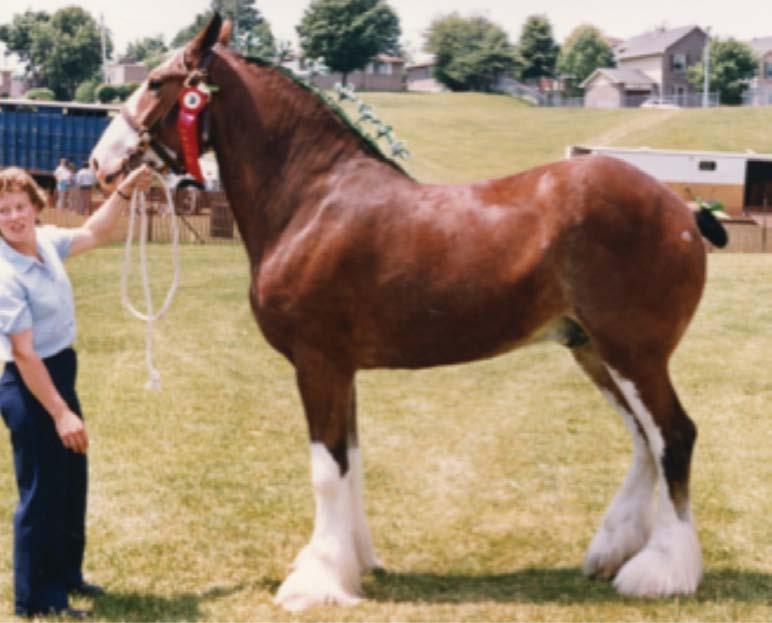 Clydesdale, Heavy Horse Show
Contestant, Aurora Fair and Horse Show, c. 1970-1980
Clydesdale, Heavy Horse Show
Contestant, Aurora Fair and Horse Show, c. 1970-1980
Heavy Horse Show Contestants, Aurora Horse Show, c. 1948 Aurora Museum & Archives (2018.6.45)
Photo Courtesy of Richard Ruddock
LIGHT HORSE COMPETITIONS
Light horses are a smaller and more delicate breed of horse than heavy horses. Examples of light horse breeds include Andalusian, Arabian, Appaloosa, and Bay. Light horses are typically bred and used for riding, driving, showing, and racing. Light horses are not typically used for farm work because their muscle structure is adapted for speed and agility rather than strength.
 Light Horse Show Contestants, Aurora Horse Show, 1948 Aurora Museum & Archives (2018.6.83b)
Light Horse Show Contestants, Aurora Horse Show, 1948 Aurora Museum & Archives (2018.6.83b)
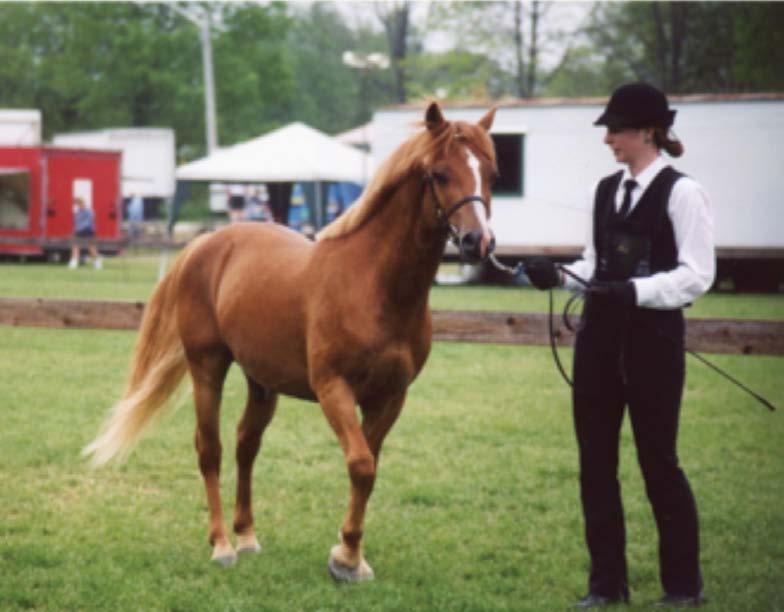
 Light Horse Show Contestant, Aurora Fair and Horse Show, c. 1980
Photo Courtesy of Richard Ruddock
Light Horse Show Contestant, Aurora Fair and Horse Show, c. 1980
Photo Courtesy of Richard Ruddock
Light Horse Show Contestant, Aurora Fair and Horse Show, c. 1980
Photo Courtesy of Richard Ruddock
Light Horse Show Contestant, Aurora Fair and Horse Show, c. 1980
Photo Courtesy of Richard Ruddock
PONY COMPETITIONS
Ponies are small-sized horses bred for farm support rather than work or racing. Historically, ponies have been featured at county fairs to provide rides for small children. Today, most ponies are used as therapy horses for humans and farm animals, as well as for children’s riding lessons.
Aurora Museum & Archives (2018.6.53)
Children participating in a Pony Competition, Aurora Horse Show, 1948

Aurora Museum & Archives (2018.6.94)
 Pony Class Competitor, Aurora Horse Show, 1948
Pony Class Competitor, Aurora Horse Show, 1948

 Children enjoy a pony ride, c. 1996
Photo Courtesy of Richard Ruddock
Various sized horses and drivers, c. 1980
Photo Courtesy of Richard Ruddock
Children enjoy a pony ride, c. 1996
Photo Courtesy of Richard Ruddock
Various sized horses and drivers, c. 1980
Photo Courtesy of Richard Ruddock
BACK in the SADDLE
In the winter of 1945, the Aurora Agricultural Society announced that the Aurora Horse Show would return to Town Park for the summer of 1946.
On Saturday, June 8th, 1946, 277 participant entries were submitted to compete at the Aurora Horse Show, and it was reported that between 4,000 and 5,000 people attended: the highest attendance in the show’s history! Fred Gardiner, K.C., Warden of York County, officially opened the show and delivered an enthusiastic speech. Other opening day speakers included W.M. Cockburn, York County agricultural representative, Aurora Mayor Ross Linton, and Elton Armstrong, President of the Aurora Agricultural Society.
The 1946 show included a variety of popular attractions, such as the horse jumping events, the refreshment booths, and the Aurora Lions’ Boys Band, who played for show visitors all afternoon on opening day. In addition to these events, a big dance where Billy Hole and his Orchestra provided musical entertainment, and a bingo game were both held at the Armoury.
The horse show’s return in 1946 re-established it as a permanent event in Aurora and hearkened back to its former glory from the 1920s and 1930s. The show continued to grow at an incredible pace, and by 1965, it ranked second in Canada for total prize money awarded.
34
• THIRTY-FOUR



THIRTY-FIVE • 35
Prize List, 1946 Aurora Museum & Archives (990.8.28p)
Speeches, Aurora Horse Show, c. 1948 Aurora Museum & Archives (2018.6.4)
Three Mounted Riders, Aurora Horse Show, c. 1948 Aurora Museum & Archives (2018.6.59b)



36 • THIRTY-SIX
Competitor Matt McDougall, Aurora Horse Show, 1950
Gift from the Wallace Family, taken by local photographer G. Barrager, Aurora Museum & Archives (2023.4.15)
Shirley Ryman, Aurora Horse Show, 1950
Photo Courtesy of Greg Bennett
The M.D. Richardson trophy plate, won by Shirley Ryman in 1950 Aurora Museum & Archives (2023.3.1)

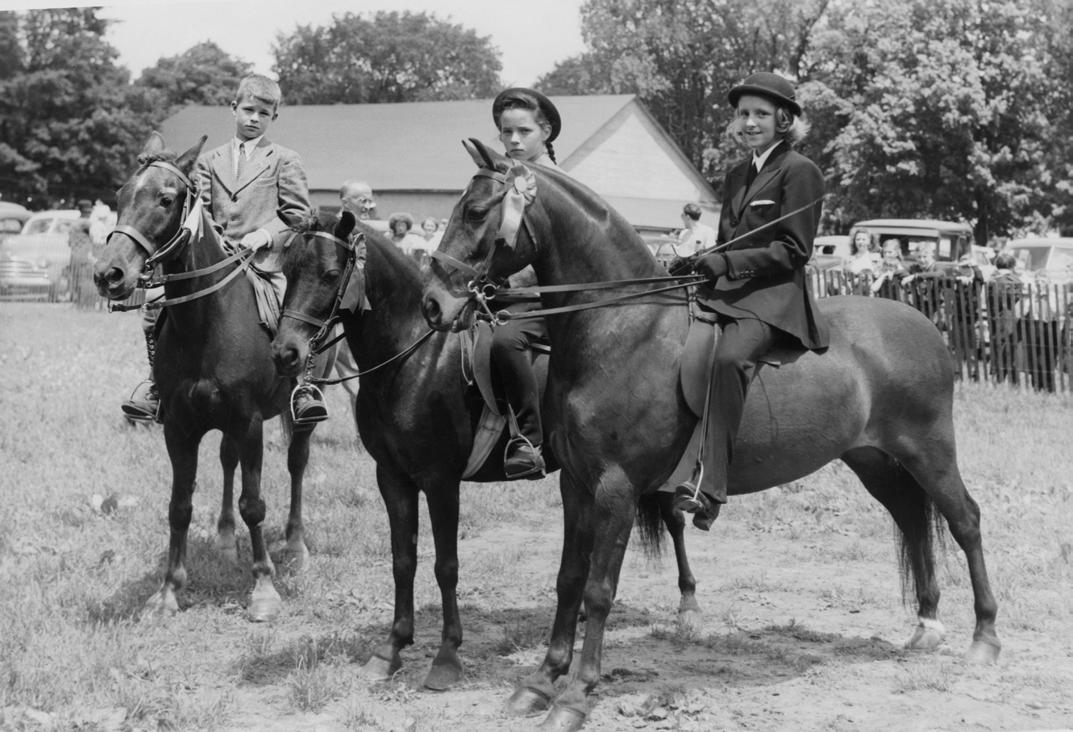
THIRTY-SEVEN • 37
Jumping Contestant, Aurora Horse Show, 1950
Gift from the Wallace Family, taken by local photographer G. Barrager, Aurora Museum & Archives (2023.4.10)
Winners of the Riding Competition, under 12, left to right: Bill Pate Jr, 3rd place, Lois Blum, 2nd place, Mary Welch on her horse Jimmy Fleetfoot, 1st. Gift from the Wallace Family, taken by local photographer G. Barrager, Aurora Museum & Archives (2023.4.8)
Aurora

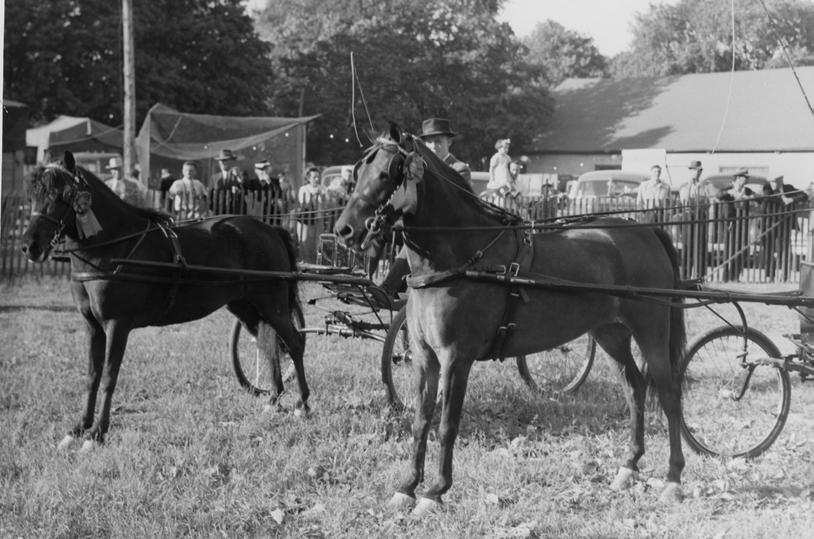
38 • THIRTY-EIGHT
Horse Show, 1950
Gift from the Wallace Family, taken by local photographer G. Barrager, Aurora Museum & Archives (2023.4.18)
O’Keefe’s Brewery Clydesdale team, Aurora Horse Show, 1950
Gift from the Wallace Family, taken by local photographer G. Barrager, Aurora Museum & Archives (2023.4.28)



THIRTY-NINE • 39
George Zimmerman holds a trophy won with his Clydesdale team, Aurora Horse Show, 1950 Gift from the Wallace Family, taken by local photographer G. Barrager, Aurora Museum & Archives (2023.4.12)
Prize List, 1951 Aurora Museum & Archives (990.8.28t)
Prize List, 1950 Aurora Museum & Archives (990.8.28s)
The Mutt Show
In 1955, the Aurora Horse Show officially added a Mutt Show. It was originally known as “Dr. Ballard’s Mutt Show” because its initial sponsor was Dr. Ballard’s Animal Food Ltd.
Typically found at traditional dog shows, a Mutt Show is a dog competition intended for mixed breed dogs or mutts. In a Mutt Show, dogs are judged less stringently, and contests are designed to celebrate a dog’s unique features and personality. Mutt Shows are suitable for wider audiences, making them popular attractions at county fairs and festivals.
Despite being advertised as a children’s event, the Mutt Show attracted visitors of all ages and allowed participants to enter their dogs in a variety of contests, including best dressed, longest tail, shortest tail, and best overall mutt. In 1963, it was hailed as Ontario’s largest mutt show, its 110 entries surpassing the show at the Canadian National Exhibition.
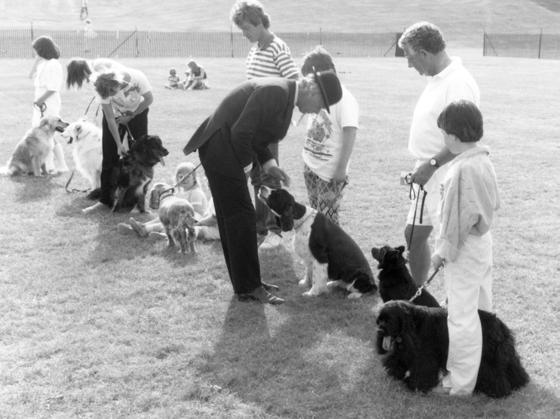

40 • FORTY
Mutt Show, c. 1980
Photos Courtesy of Richard Ruddock
Mutt Show, c. 2000
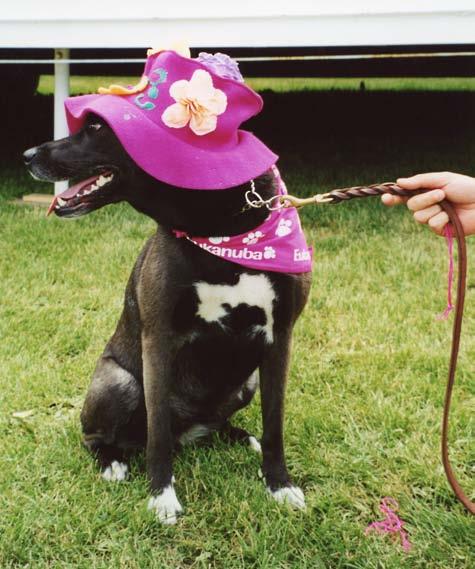
Mutt Show Flyer, 1987
 Photo Courtesy of Richard Ruddock
Photo Courtesy of Richard Ruddock
FORTY-ONE • 41
Photo Courtesy of Richard Ruddock
An Olympic Homecoming
The 1969 Aurora Horse Show was the homecoming welcome for Canada’s Gold Medal winning Equestrian Team comprising Jim Elder, Tom Gayford, and Jim Day, all residents of the area.
The team was fresh off their win from the Mexico City 1968 Summer Olympic Games where they earned Canada’s first gold medal in equestrian sports. Approximately 10,000 people filled Town Park to be part of the show and celebrate Canada’s Gold Medal Equestrian Team. As part of the celebrations, show organizers arranged a special opportunity for locals to meet the Olympic Team.
 Jim Elder with his horse Beefeater at the Aurora Horse Show, 1970
Jim Elder with his horse Beefeater at the Aurora Horse Show, 1970
42 • FORTY-TWO
Photo Courtesy of Jim Elder and the Aurora Sports Hall of Fame
Jim Elder’s gold medal from the Mexico City 1968 Summer Olympic Games

A crowd of attendees at the 1969 Aurora Horse Show Aurora Banner, June 18, 1969

FORTY-THREE • 43
Photo Courtesy of Jim Elder and the Aurora Sports Hall of Fame
A New Stomping Ground
As the popularity of the Horse Show grew, space and facilities became an issue. The evolving nature and size of the show’s various attractions, combined with the increasing number of visitors attending each year, demanded a more spacious venue. In 1971, the Horse Show was moved to the newly expanded Machell Park ending the Aurora Horse Show’s forty-three-year tenure in Town Park. Machell Park would remain the home of the Horse Show until 2006.
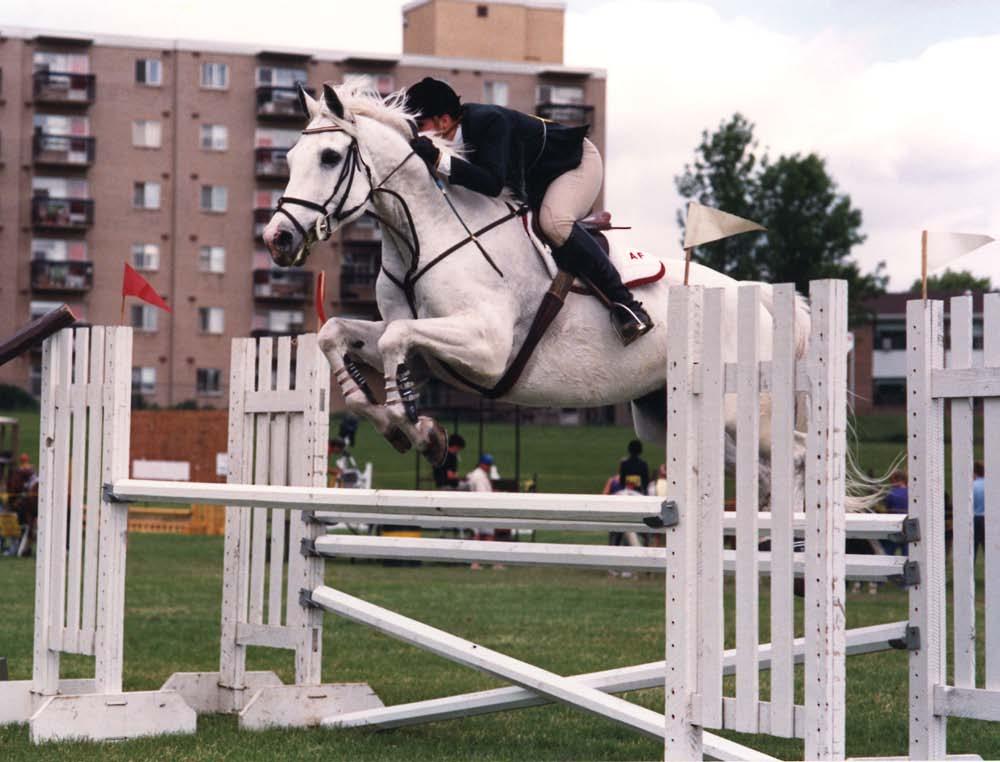
44 • FORTY-FOUR
Horse & Rider Mid Jump Over a Fence, Aurora Horse Show, c. 1980
Photo Courtesy of Richard Ruddock


FORTY-FIVE • 45
Overview of Course, Aurora Horse Show, 1975
Photo Courtesy of Jennifer Zsolt
Competitor at the Aurora Horse Show, 1983
Photo Courtesy of John Sanderson

 Machell Park all set up for the Aurora Horse Show, c. 1990
Machell Park all set up for the Aurora Horse Show, c. 1990
46 • FORTY-SIX
Photo Courtesy of Sylvia Gilchrist
Competitor at the Aurora Horse Show, c. 1990
Photo Courtesy of Sylvia Gilchrist
SHOW JUMPING and DRESSAGE
Two of the highest expressions of Equestrian sport are Dressage and Show Jumping. In Dressage, the horse and rider must execute highly accurate movements with an emphasis on the horse’s attentiveness and responsiveness. Horses may perform intricate trots or steps but do not jump.
In a Show Jumping competition riders must complete a series of jumps that can take the form of hurdles, fences, and/or obstacles. The three main styles of jumps are vertical, oxer, and triple bar, each one increasing in length and difficulty. The goal for each rider is to complete every jump in the course within the set time limit – without incurring any penalties.
The Aurora Horse Show has always been, at its core, a Jumping show, and has over the year hosted some extraordinary riders and witnessed some beautiful jumps.

 Show Jumping Contestant, Aurora Horse Show, c. 1948 Aurora Museum & Archives (2018.6.92)
Show Jumping Contestant, Aurora Horse Show, c. 1948 Aurora Museum & Archives (2018.6.96)
Show Jumping Contestant, Aurora Horse Show, c. 1948 Aurora Museum & Archives (2018.6.92)
Show Jumping Contestant, Aurora Horse Show, c. 1948 Aurora Museum & Archives (2018.6.96)
Show Jumping Contestant, Aurora Horse Show, 1950
Show Jumping Contestant, Aurora Fair and Horse Show, c. 1980


 Show Jumping Contestant, Aurora Horse Show, 1950
Gift from the Wallace Family, taken by local photographer G. Barrager, Aurora Museum & Archives (2023.4.5)
Photo Courtesy of Richard Ruddock
Gift from the Wallace Family, taken by local photographer G. Barrager, Aurora Museum & Archives (2023.4.30)
Show Jumping Contestant, Aurora Horse Show, 1950
Gift from the Wallace Family, taken by local photographer G. Barrager, Aurora Museum & Archives (2023.4.5)
Photo Courtesy of Richard Ruddock
Gift from the Wallace Family, taken by local photographer G. Barrager, Aurora Museum & Archives (2023.4.30)
CHANGING with the TIMES
The horse show had been operating as a fair for many years but did not include the moniker in its title until 1985. Fair-like attractions were continually added to the show’s official offerings. The midway was the largest of these added attractions and became the horse show’s main attraction for generations of Auroran youth.
The midway had been officially added to the Aurora Horse Show in 1946, when officials were looking for newer and bigger attractions for the first post-war show. The midway was primarily intended to attract younger audiences to the show, but it also provided show organizers with an additional benefit: a revenue stream generated from all the different games. In 1976, an expanded and enhanced midway was promised, and the next year Conklin Shows was contracted to operate the rides and games. This brought the fair to the peak of its amusement amenities, and the midway continued to be a large part of the show for the next 30 years.

50 • FIFTY
Poster for the 1997 Aurora Fair and Horse Show Courtesy of the Town of Aurora
Children’s Train Ride, Aurora Agricultural Society Fair and Horse Show, c. 2000

Fair and Midway, Aurora Horse Show, 1975
Midway, Aurora Fair and Horse Show, c. 1990-2000


Spectators enjoy a carnival themed performance, Aurora Fair and Horse Show, c. 1990

FIFTY-ONE • 51
Photo Courtesy of Richard Ruddock
Photo Courtesy of Richard Ruddock
Photo Courtesy of Jennifer Zsolt
Photo Courtesy of Sylvia Gilchrist
The Trillium Circuit
In 1985, the Aurora Agricultural Society hosted a Trillium Circuit competition for junior and amateur class riders as part of the horse show schedule. The Trillium Circuit was administered by the Trillium Hunter Jumper Association, who were established in 1983 and tasked with bridging the gap between amateur showings and the “A” Circuit.
To accommodate for the growth of the Aurora Horse Show, in 1986, it was expanded to take place over two weekends. The first weekend in June was dedicated to the Trillium Hunter Jumper show, and the other Aurora Horse Show activities and events would take place during the second weekend in June.
The addition of the Trillium Circuit would become a permanent feature, and from this point on, the Aurora Agricultural Society was tasked with organizing two separate, but complimentary events.
52 • FIFTY-TWO
Baby Contest
Baby contests have been popular at fairs and festivals across North America since the early 20th century, and Aurora was no exception.
Baby contests were held in Aurora from the turn of the 20th Century, and were a feature at many other local events. During the 1980s, the Aurora Horse Show baby contest became a popular feature that would take place annually until the last show in 2006.
The contest was divided into a boys and girls section, with 6-12 months and 12-24 months age groups. Due to the popularity of the baby contest, participants needed to register in advance and participation was capped at 25 babies in each age group. The babies could then win prizes in categories such as cutest baby, best multiples, best dressed, and best personality.
The baby contests were sponsored by various companies and local businesses, such as Gerber, Luvs, Pampers, and Doane Hall Pharmacy. The baby contest was always a popular event for participants and visitors.

FIFTY-THREE • 53
Baby Contest, Aurora Fair and Horse Show, c. 1980
Photo Courtesy of Richard Ruddock



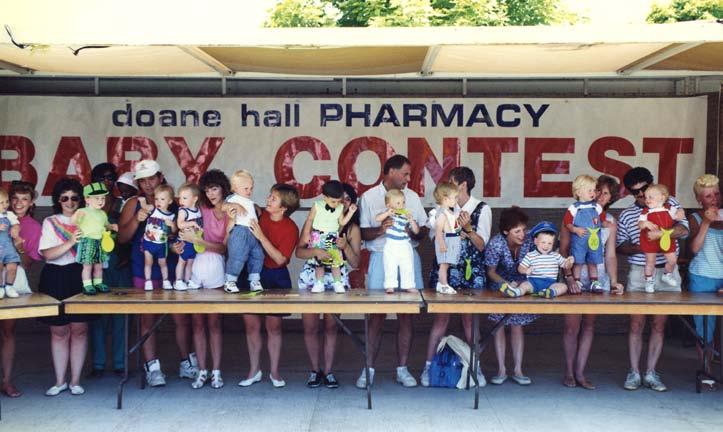
54 • FIFTY-FOUR
Baby Contest Flyer, 1992
Photo Courtesy of Richard Ruddock
Baby Contest, 1984
Photo Courtesy of Richard Ruddock
Baby Contest Contestant, 1984
Photo Courtesy of Richard Ruddock
Baby Contest, Aurora Fair and Horse Show, 1992
Photo Courtesy of Richard Ruddock
Children’s Competitions
The Aurora Horse Show hosted a variety of children’s competitions under the umbrella of the Ladies’ Section.
As early as the 1960s, children could compete in baking competitions for cookies, cakes, and biscuits, flower competitions for wildflower arrangements and birthday centerpieces, and craft competitions for ceramics, poster design, sketches, quilting, and sculpture. Children from kindergarten to grade twelve could enter a variety of categories in the Junior Arts Competition.
The Junior Arts Competition was divided into four colour classes. There was a “yellow class” for children in kindergarten to grade two, a “red class” for children in grades three to grade five, a “blue class” for children in grades six to grade eight, and a “green class” for grades nine to grade twelve. Each class included competitions in amateur art, crafts, photography, poster competition, jellybean counting, and chocolate chip cookie baking. All Junior Arts winners could receive place ribbons, honourable mention ribbons, or special rosettes for either the People’s Choice Award, the Director’s Choice Award, and/ or the Junior Director’s Award.
Children Participating in the Children’s Quilting Category, 1984

FIFTY-FIVE • 55
Photo Courtesy of Richard Ruddock
Chocolate Chip Cookie Award and Ribbon, 2006


Spinning wheel activity, c. 1990

Prize-winner in the 2004 “Yellow Class”
Junior Arts Competition, Crafts Category Winners, c. 2000


Junior Arts, Crafts and Photography Competition, c. 1990-2000

56 • FIFTY-SIX
Photo Courtesy of Sylvia Gilchrist
Courtesy of Leona Rodall
Photo Courtesy of Silvia Gilchrist
Photo Courtesy of Leona Rodall
Photo Courtesy of Silvia Gilchrist
Miniature Horse Show
In the early 1990s, the Light Horse, Pony, and Miniature Horse competitions were combined formally into the Light Horse & Pony Show. One of the categories in this newly created combined show was a dedicated Miniature Horse show.



A crowd favourite at the Miniature Horse Show was the costume category. A crowd favourite at the Miniature Horse Show was the costume category. Horses in this category, and their handlers, dressed up in various themed outfits. Some outstanding costume entries from the 1996 show included Santa Claus, Elvis Presley, and a bride and groom.

FIFTY-SEVEN • 57
Western Pleasure Open Miniature Horse Class, 1996
Photo Courtesy of Richard Ruddock
“Elvis,” Costume Category, Miniature Horse Show, 1996
Photo Courtesy of Richard Ruddock
Costume Category Miniature Horse Show, 1996
Photo Courtesy of Richard Ruddock
In Hand Class, Miniature Horse Show, 1996
Photo Courtesy of Richard Ruddock
Mounted Sack Race
Another popular event at the Aurora Horse Show was the mounted sack race, a staple horse show and county fair event since the early 1930s.


In a mounted sack race, participants are given a burlap sack to stand in and are paired with a horse. The participant must successfully navigate around a course in their sack while guiding their equine teammate. This can prove quite difficult for the one wearing the sack, and hilarious for the crowd.

58 • FIFTY-EIGHT
Mounted Sack Race, c. 1970
Photos Courtesy of Richard Ruddock
ANATOMY of a FAIR
Horse shows may have been held as far back as the 7th century BCE in Ancient Greece, while fairs can be traced back even farther. Countries and cultures around the world have their own type of fair with each blending both economic and social functions into one large community event. There are street fairs, county fairs, state fairs, trade fairs, travelling fairs, also known as carnivals, and world’s fairs or expositions. Fairs have a wide variety of attractions from Ferris Wheels and other rides, midway games, food stalls, music, face-painting, clowns, and animals. Since 1946, the Aurora Horse Show has included all these types of attractions.


 Carnival Rides at the Aurora Horse Show, 1948 Aurora Museum & Archives (2018.6.47)
Ferris Wheel in the Background, Aurora Horse Show, Town Park, 1950
Gift from the Wallace Family, taken by local photographer G. Barrager, Aurora Museum & Archives (2023.4.7)
Carousel in the Background, Aurora Horse Show, Town Park, 1950
Gift from the Wallace Family, taken by local photographer G. Barrager, Aurora Museum & Archives (2023.4.3)
Carnival Rides at the Aurora Horse Show, 1948 Aurora Museum & Archives (2018.6.47)
Ferris Wheel in the Background, Aurora Horse Show, Town Park, 1950
Gift from the Wallace Family, taken by local photographer G. Barrager, Aurora Museum & Archives (2023.4.7)
Carousel in the Background, Aurora Horse Show, Town Park, 1950
Gift from the Wallace Family, taken by local photographer G. Barrager, Aurora Museum & Archives (2023.4.3)
Prize-winner at the Aurora Fair & Horse Show, c. 1990
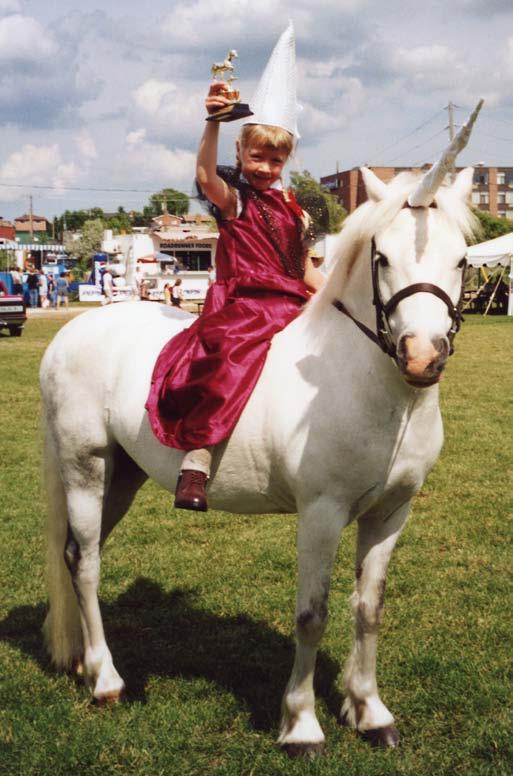
Magic Show at the Aurora Fair and Horse Show, c. 1990

A Couple is Swept up in the Moment, c. 2000
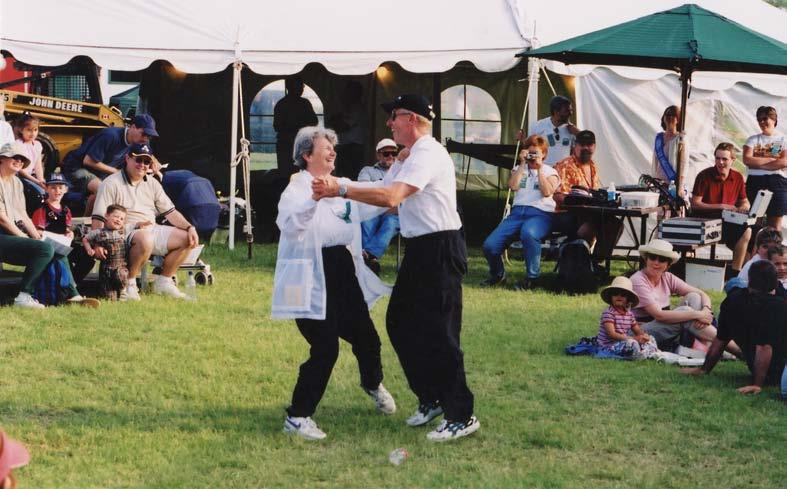 Photo Courtesy of Richard Ruddock
Photo Courtesy of Syliva Gilchrist
Photo Courtesy of Richard Ruddock
Photo Courtesy of Richard Ruddock
Photo Courtesy of Syliva Gilchrist
Photo Courtesy of Richard Ruddock
FAREWELL to the FAIR & HORSE SHOW
For some Aurorans, the end of the Aurora Horse Show was seen as inevitable considering that town priorities were evolving. What had seemed necessary and popular in past years was no longer as engaging.
During the first Aurora Horse and Pure Bred Stock Show in 1923, Aurora was surrounded by farms, and was considered a destination for professional and hobby horse breeding. By the mid-2000s, the town had outgrown its role as an equine and agricultural destination. The once-thriving Aurora Agricultural Association was facing volunteer and funding challenges that made it difficult to continue operating the show.
Bye-Bye Bingo
“ The
(Poor Richard’s Scrapbook, The Auroran, November 14, 2006)
62 • SIXTY-TWO
Aurora Horse Show needs help, And very urgent is the need: Unless the province changes policies, We may never see another steed!”
Between 2000 and 2006 the Horse Show was sometimes Referred to as the Aurora Agricultural Society Fair and Horse Show Courtesy of Richard Ruddock

By the turn of the century, the Aurora Fair and Horse Show was funded by local business sponsorships, the Town of Aurora, and largely through revenue generated at local bi-weekly bingo games.
To receive some of the profits made from local bingo games, five volunteers from the Aurora Agricultural Society needed to volunteer at the bingo game that took place on the second Monday of every month. On average, the Society would collect $25,000 – 30,000 annually from the bingo proceeds, which paid for a significant portion of the Aurora Fair and Horse Show expenses.
The bingo operation was licensed by the Alcohol and Gaming Commission of Ontario (AGCO), who were responsible for categorizing each charity and event that received profits. For many years, the Aurora Fair and Horse Show was classified as a Heritage and Culture event. This categorization allowed the society to spend the bingo proceeds on a wide variety of fair-related activities and events, without many restrictions.
In 2005, rather unexpectedly, the AGCO re-classified the Aurora Fair and Horse Show as an Enhancement of Youth event. This seemingly minor change would have a dire effect on the future of the show. Charities and events that were in the Enhancement of Youth category were limited in how they could spend the bingo proceeds; all earnings needed to be used exclusively for direct sponsorship of youth activities.
The Aurora Fair and Horse Show was an inter-generational event in the truest sense. By restricting the use of bingo proceeds to youth related activities, a large portion of the event’s activities and attractions were left without funding.
SIXTY-THREE • 63
The Last Aurora Fair & Horse Show
In 2006, extremely wet weather the first week of June reduced the competitions in the Trillium Hunter Jumper event, and by the next week, the ground was still saturated when the public lined up for the Aurora Fair & Horse Show.

The ground was determined to be too wet for horses to safely perform, resulting in the cancellation of all horse-related events. The remainder of the fair went on, but their problems were not yet over.
Throughout the Fall of 2006 and into the Spring of 2007, various public meetings and donation drives were held across Aurora to generate the support needed to save the Aurora Horse Show, and to make up for the funds lost to the AGCO ruling. The sponsorships and volunteers that were secured were insufficient, and the Agricultural Society announced that they would not, for the first time since 1946, hold their usual Fair & Horse Show.
64 • SIXTY-FOUR
A Scene from the Aurora Fair and Horse Show, c. 1990
Photo Courtesy of Sylvia Gilchrist
Official Announcement Regarding the Future of the Aurora Fair and Horse Show and the Aurora Agricultural Society Courtesy of Richard Ruddock

Promotional Ad for the Aurora Fair & Horse Show, 2006 Courtesy of Richard Ruddock

SIXTY-FIVE • 65


66 • SIXTY-SIX
Pamphlet for the Aurora Fair and Horse Show, 2006 Courtesy of Richard Ruddock
The One Final Trillium Bloom?
The Agricultural Society continued to push for some form of equine competition for 2007, even if it was to be the Trillium Hunter Jumper Show rather than the locally organized event. Hoping to use Machell Park as usual, the Society was dismayed to learn in March that the park had been booked for use by the local youth soccer league.
They examined other options, such as the Magna grounds at Wellington and Bayview, or Joker Hill in King, where Trillium events had previously been held. In April, the case was brought before Aurora’s Town Council who ultimately approved the use of the Machell Park for the Trillium show. Unfortunately, despite the victory in Council, the Trillium Association backed out of the show, citing insurance costs.
It turns out that Poor Richard was correct in his poetic plea, and the final hoofs that stomped the ground at Machell Park were those of the rainy Trillium show in 2006. With no horse events taking place at all in 2007, and a dearth of funding and volunteers, the Aurora Agricultural Society decided to formally cancel the Aurora Fair & Horse Show. The decision was made at their November 5th meeting, and the formal announcement came soon after. Furthermore, the Agricultural Society itself would be ceasing operations in early 2008, after 84 years, marking the end of an era and closing a major chapter in Aurora’s history.
SIXTY-SEVEN • 67
Come Again Some Other Day
Rain plays a curious role in the history of the Aurora Horse Show, likely causing the cancellation of Aemilius Jarvis’

1922 Hurdle Jumping Show in Town Park, and striking again in 2006, scuttling what would have been the last horse competitions of the final Aurora Fair & Horse Show.
This reminds us of both the power and fragility of these majestic animals, and that many things that seem strong and resilient, horses and horse shows alike, are vulnerable to changing environments.

68 :: SIXTY-EIGHT
Competitor, 1983
Photo Courtesy of John Sanderson
Competitor, c. 1990
Photo Courtesy Richard Ruddock
MEMORIES
As part of our tribute to the 100th anniversary of the Aurora Horse Show, the Aurora Museum & Archives asked members of the extended Aurora community if they wished to share some of their memories of the Aurora Horse Show.
These memories are included here and highlight the importance the Aurora Horse Show held for so many people.
DEBORAH CAMPO
From my early rural childhood, I always loved watching the majestic, beautiful nature of horses in their pastures. My first vivid memory was the classical carousels of finely painted horses, which to a child of five were a beginning of magical rides.
As a teen I rode western continuing this relationship of respect to their strength and carriage, all while feeling a sense of freedom in the saddle. Thus it became a natural fit to enjoy my passions, the love of horses by combining my life career as a visual artist & poet, to volunteer and be a part of the Aurora Agricultural Fair and Horse Show as the Festival of Arts Tent Coordinator for fifteen years, and an associate director for a few until the fair’s ending in its eighty fifth year. Located at Machell Park the public was invited to tour “The Festival of Arts Tent” showcasing a variety of local and provincial artists and craftsman’s exhibiting various styles of original works for purchase. More to discover inside were the beautiful displays of quilts, exciting demonstrations of spinning and weaving from the Huronia Spinners Guild, stone cutting from Calvin Jones of Rock of Ages, and various artists painting demonstrations. Many talented artists participated over the years, and I truly thank and appreciate each one for
their contribution to the “Festival of Arts Tents” success. The following artists and craftsmen participated in 2004 and 2005 just prior to the fair’s closure: Graham Ames
Metal Sculpture, Braided Rug Lady, Deborah Campo Mixed Media: Acrylics Poetry Books, Angel Cards, Hand Painted Glass, Julie Cheeseman Oils & Jewellery, Jeannie Clark Print Making, Creative Connections Anne Winfield & Bev Simpsons
Children’s Crafts & Various Artists,
Dania Ellis Mosaics, Peggy Grigor Pottery, Huronia Spinners Guild June Sorenson, Jim Loeb quilting spinning & weaving, Kent Hunter Wood Carver Wild Life
Sculpture, Linda Lehman Hemp Jewelry, My Lady Jewelry Jack Brice & Lin Lyons
Stone Jewelry, Jacqueline Okuhara & Lisa Hastings Mixed Media, Lindsay Pattilo of Pattilo Painters Oils Landscape, Susan Perek Acrylics Watercolour, Roma Crafts, Rock Of Ages Calvin Jones
Stone Cutting Demonstrations, Christine Valentini Oils & Watercolour, Cindy Van Oorschot Paper Crafts & Greeting
Cards, Bill Van Oorschot Oils Landscape, Dorothy Wintle Oils Landscape Portraits, and Michael Wang Calligraphy.
The Festival Of Arts Tent became well attended over the years for various special art projects: Anne Winfield “Creative Connections” delightful make and take
crafts. The 78th Aurora Agricultural Fair and Horse Show June 12 & 13, with guidance from “The Aurora Abstracts”: Artists Helen Barcza, June Dale, Christina Tatomyr-Melnyk and myself which I am founder, produced four spontaneous artworks painted in acrylics on canvas and paper for “The 1999 Millennial Children & Adult Agricultural
Digital Artwork to Celebrate the 100th Anniversary of the Aurora Horse Show
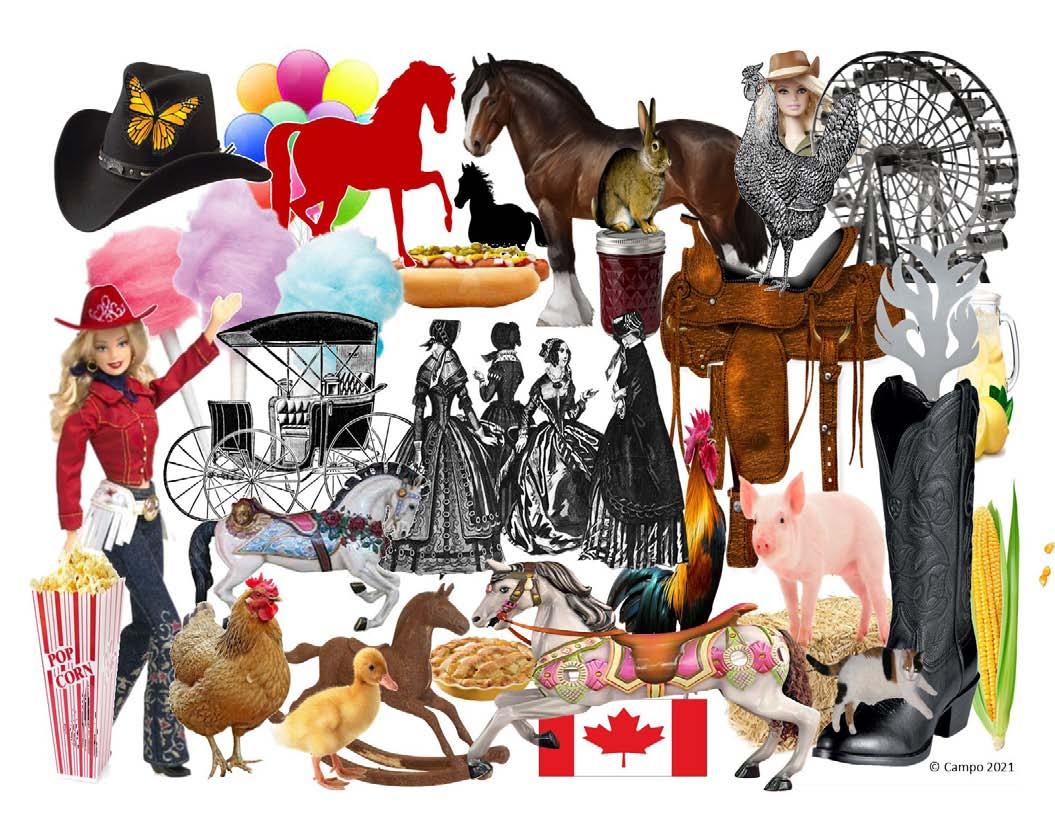 Created by Deborah Campo, 2021
Created by Deborah Campo, 2021
Heritage Painting Project.” These paintings were bestowed to our town preserving the celebration of agriculture in art. Entitled “Agriculture 21st Century #1”, “Agriculture 21st Century #2” both acrylics on canvas 24” x 30”, and “Rooster Run”, “Y2K Future Farm” both acrylics on paper 26”x 40”. I adored teaching art per “Campo Art Kids Camp” directing children in pet rock painting, farm animal colouring projects, gift wrap paper design, bead bracelets and fruit loop necklace making. A unique exhibit of the “Historica” Regional Heritage Fair History Student Winners grades 4 to 8 added to our tent’s inspiring atmosphere. Lastly an imaginative amusing fun entry favourite for children and teens was the creative Junior Arts, Craft and Photography Competition, which was a blast, to be able to Judge for a few years with Linda Schneidereit. My daughter Kyla took home several ribbons in photography including a first-place ribbon for her “Rules For Coaches” page relating to her love of soccer and the do’s and don’ts for parents watching the game. I bowed out from
judging her entries, but I was a proud mom all the same. The Festival of Arts Tent provided a creative, educational, and visual learning experience for all ages. The artists themselves had fun participating, despite enduring unusual weather periods over the years, including heavy rains that would flood our 100’ x 40’ tent.
The Aurora Agricultural Fair and Horse Show Fair brought together our agricultural community, local businesses, and residents with a well-respected honoured tradition. I can still remember enjoying my walks through the fairgrounds delighting in the many events: Opening Ceremony with the Saint Andrews College Pipers and the Governor General Horse Guards, Grand Prix, Heavy Horse Show, Creatures Exotic with Dan The Reptile Man, Birds of Prey with Birdman Bob, The Ben Show Juggler Stilt Walker Ben Burland, Super Dogs, Pony Show, Bandaloni The One-Man Band, Animal Petting Zoo, Children’s Tractor Pull, Sheep Shearing, Pig and Duck Races, Classic Cars, Stage Shows of musical and theatrical
“ An imaginative amusing fun entry favourite for children and teens was the creative Junior Arts, Craft and Photography Competition, which was a blast, to be able to Judge for a few years with Linda Schneidereit.”
talents where I performed reading from my published poetry book “On Angel’s Wings and Moonbeams” along with other writers. The fun continued with the Midway Rides and Games all while you could enjoy roasted corn on the cob or having a cotton candy delight that would always stick to your fingers no matter how careful you were. The fair could not be without the display of “The Fleury Plough”, agricultural machinery of a single furrow walking plough created by Joseph Fleury Jr. 1859 of Aurora, Ontario, Canada.
Appreciation goes to the many sponsors, community volunteers the Board of Directors and Associate Directors: Maurice, Debbie, David & Joanne Blanchard, Sue & Rick Browne, Silvia & Jim Gilchrist, Andy & Liz MacPherson, Richard Ruddock, and Linda Schneidereit who tirelessly worked to create the fairs displays, livestock shows, competitions, entertainment, and attractions.
Our dedicated group came back together for another creative event supporting the Aurora Agricultural Fair And Horse Show, by set building and decorating our Christmas float for our towns “Under The Stars Santa Claus Parade”. I had so much pleasure in helping to decorate our holiday themed float arranging on it bales of hay wrapped in
festive red ribbons. During the parade our float was pulled by heavy horses. Wearing my long red coat matching red cowboy hat decorated in Christmas ribbons and ornaments I was a thrilled to be one of participants who sat on the float with other fair members. Crowds of citizens watching from the sidewalks erupted with continuous loud cheering along the parade route. This made all of us on the float believe ours was a captivating, whimsical designer fan favourite. In part perhaps, but the real fact unbeknown to all of us sitting on the float was, our clean up crew behind was dancing and twirling with their garbage cans on rollers continually scooping up horse’s droppings so the parade marchers behind them wouldn’t be stepping in any. A hilariously funny moment when we realized this, and a great time had by all.
Sadly, due to cost increases and decline of volunteers the Aurora Agricultural Fair and Horse Show came to an end in 2006. I congratulate the beginning founders of the Aurora Horse Show and Fair of 1922 originally held at Aurora’s Town Park. I have thoroughly loved and enjoyed every year of this experience, making long lasting friends and great memories.
Deborah Lynn Valerian Campo Aurora Artist & Poet
SYLVIA GILCHRIST
The Aurora Fair and Horse Show was divided into two parts: on the first weekend in June of each year at Machell Park was the Trillium Horse show which included the hunter/jumper horse competitions.
I was not involved in this part, but Sue Browne was. She later became the secretary of the Fair and Horse Show. The second part was on the second weekend in June, also in Machell Park, when the Fair and Horse Show happened. I was very much involved in this part first as a volunteer, then a Board member, then as secretary for a number of years and finally a volunteer again. When I could no longer carry on as the secretary because I was frequently flying back and forth to England to take care of my elderly parents, Sue Browne (or Sue Young as she was at that time) took over from me as secretary.
When I first volunteered in 1992 or 1993 Sharon Menczel was secretary. She left and Debbie Blanchard became secretary for a year or two followed by Kathryn Hicks for one or two years. When Kathryn resigned, I became secretary of the Fair and Horse Show.
When I took on the role of secretary, there was no permanent record in one place of all the contacts and items that went into organizing the Fair and Horse Show. One of the first things I did was to prepare a list detailing everything we had to do to prepare for the Fair. It showed the name, address, telephone number, who was responsible for contacting them, and the final result. Initially, we would meet each month and as we got closer to the date we would meet every two weeks to ensure that everything was booked and ready to go. It was a huge job and the Board was run by volunteers. At the time Peter Dagenais was the president. When the Fair ran into financial difficulties, we introduced items that didn’t cost any money, such as several children’s activities, including the Superkids Challenge. This was a fun event with prizes donated by Scholastic books. We had about six activities where the children had to show their skill. We looked for events that would be at no cost.
Another ‘freebie’ we introduced was the Festival of Arts tent where children could show their creative side and local artists could display their work.
Another no cost event was the Mutt Show. The Mutt Show was a popular event and the Mayor of Aurora at that time, Tim Jones, was always the judge. For the winners we had medallions which were provided, free of charge, by ReYork Trophies, and prizes were also given to us by Herb Williams and his
dog food sponsors. Herb was the founder of the Superdogs which were famous across North America. They were always a fixture at the Royal Agricultural Fair each year in Toronto as well as other large shows across North America. The Aurora Fair and Horse Show was the only one, or one of only a very few, where the Superdogs appeared at a local agricultural fair. It was a dog show. Herb would put the dogs and their owners through different activities, and the dogs would end each performance by sitting on
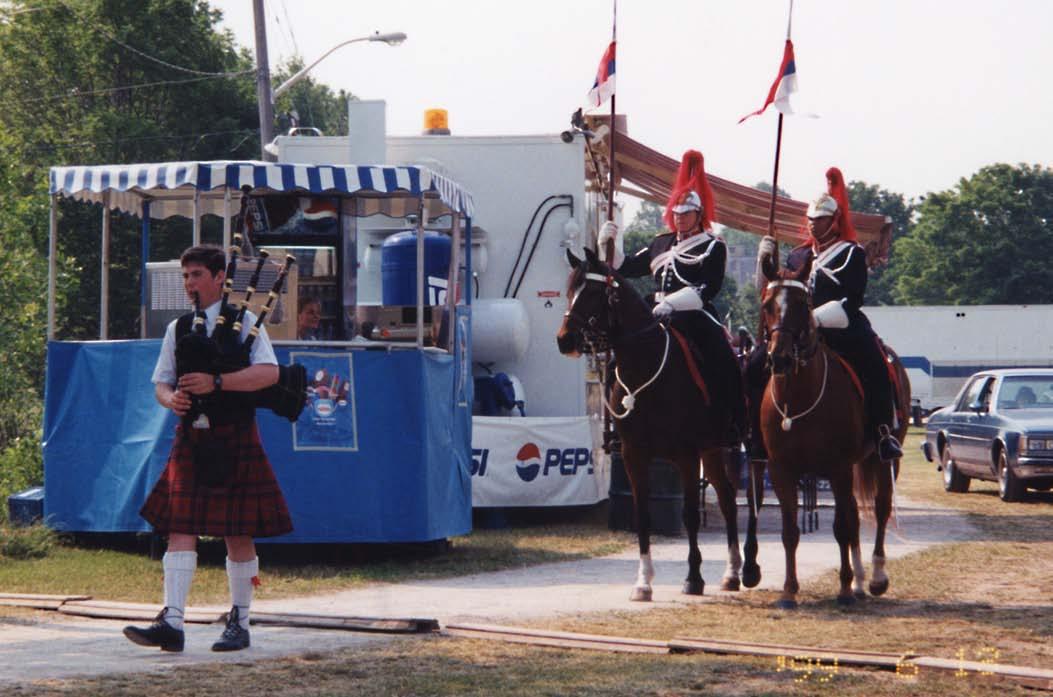 Opening of the Aurora Fair and Horse Show, c. 1990
Photo Courtesy of Sylvia Gilchrist
Opening of the Aurora Fair and Horse Show, c. 1990
Photo Courtesy of Sylvia Gilchrist
a box waiting for their treat, which could be food or a toy. Lenard Lind helped to sponsor the Superdogs at the Aurora Fair.
For the opening of the Fair and Horse Show some of the performers and volunteers would walk the fairground path behind a piper from St. Andrew’s College and horses from the Governor General’s Horse Guards. Often the piper was Jim McGillivray who was the piping master at the college, but sometimes we had a young piper from SAC who wasn’t preparing to go home at the end of the term. There would then be an opening speech and sometimes a presentation and the fair would be ready to go.
The “Horse Show” part during the second week was for the heavy horses, and light horses, including carriage and horses, and the children’s competition. Not being a horse person, I was not involved in organizing this aspect of the show. Some of the people who were involved over the years were Munroe Armstrong, Maurice Blanchard, Peter Dagenais, and others.
As the Fair and Horse show was an “agricultural fair” there were rules and regulations that we had to follow in order to count ourselves as an agricultural fair. The Ministry of Agriculture would send its
representatives to fairs to ensure that they were following the rules. Our representative from the Ministry was Andrew McPherson. Andy was always a big help. After I left, I believe he became president and was always very involved in the Schomberg Fair.
Some years we had special events such as the Naval Gun Run and Band from Nova Scotia and the RCMP Musical Horse Ride. Dale Downey was responsible for helping to bring the RCMP to Aurora.
Paying for the Fair and Horse Show was expensive. We always got financial help from the Town of Aurora. We sent letters to various businesses requesting donations, the money we received from the gate helped, but our primary source of income was from bingo. There was a bingo operation in Aurora at the time and by volunteering to help, different organizations, including the Fair and Horse Show, received funds.
The demise of the Aurora Fair and Horse show came when the bingo hall closed, and we could no longer replace the funds that we had received from them. Other factors that contributed to the demise of the Fair and Horse show was the Aurora Yonge Street Sale and the Town’s
July 1 celebrations. The Yonge Street sale was initially held to celebrate the 200th year of the founding of Yonge Street. It was so successful that the Chamber of Commerce decided to continue it each year. This was held the first weekend in June (when the Trillium Horse Show was happening) and offered free pony rides and other items that the Fair and Horse Show offered the following weekend.
The Town’s July 1st celebrations also cut into what the Fair and Horse Show offered. They often hired the same exotic animal show and other items that we had and there was no entrance fee. As a result, the Aurora Fair and Horse Show was gradually squeezed out. We weren’t attracting the same number of participants, which meant we collected less money at the gate, and it became too expensive to run.
My memories are now a bit shaky but some of the people who were important to the running of the Fair and Horse show during
the years that I was involved were Peter Dagenais, Tom Callaghan, Maurice Blanchard, Marg Wood, Patty MacLean, Rick and Sue Browne, the Bellows family, Dick Rockwell, Munro Armstrong, and many, many others. It was an exhausting and challenging time but we always felt very satisfied when it was time to wrap it up for another year. The volunteers often celebrated, as they were cleaning and packing up, with pizza in the park. The Fair and Horse Show was a fun time and I am sorry it is no more.
Sylvia Gilchrist Former Secretary of the Aurora Fair and Horse Show
“ The Aurora Fair and Horse Show was the only one, or one of only a very few, where the Superdogs appeared at a local agricultural Fair. It was a dog show.”
DAVID HEARD
As a child in 1960s Aurora, the local Horse Show was summer excitement full of smells, tastes, and adrenalin rushes.
The midway always brought screams from the park. It was a mini taste of the Canadian National Exhibition, right here in our little Aurora.
Town Park seemed big to a kid, yet Machell Park was incredible with its natural amphitheater. Hearing the announcements from the Rothmans Caravan brought roars from the large crowd.
“Zero Faults”… mass applause.
I remember back in the 60s there was a bake off competition at historic Town Park. A highlight of the event was a Cherry Pie Eating Contest. Several adult males were on stage eagerly waiting to compete.
The M.C. of the contest called out for one more competitor. I was all of nine years old and tiny for my age. Seven contestants with a chance to win seven shiny silver dollars. I raised up my hand and was welcomed onto the old band shell. I was terribly scared but the thought of making a mess with my face was thrilling.
The countdown began…
I slammed my face into that pie into those cherries and swallowed as fast as I could. Then suddenly, my hands behind my back were pulled up in the air. I had just defeated six adults in our Aurora Horse Show Pie Eating Contest. Those coins seemed like silver saucers in my hands.
I hosted the same event with a dozen youth, this was at the second year of the Aurora Farmers Market, back on Tyler Street almost 20 years ago. A $100 education bursary was the prize to the winner. To think the organizers of that 1960s, Horse Show created a ripple for another youth, still inspires me.
The Aurora Horse Show I believe gave way to help us youth just “horse around” as well. A face full of cherry pie sure proved that to a nine year old with deep roots in Aurora, to the very early 1800s.
David Heard
Lifetime Aurora Resident
The Aurora Museum & Archives gratefully acknowledges all the people, past and present, who contributed to the Aurora Horse Show and took the time to document its history.
Thank you to everyone who shared content, photos, and stories.
The Aurora Horse Show provided life long memories that continue to be passed down and cherished by many.
SEVENTY-NINE • 79
Cover photo: Show Jumping Contestant, Aurora Horse Show, 1950
Gift from the Wallace Family, taken by local photographer G. Barrager, Aurora Museum & Archives (2023.4.10)














 Aemilius Jarvis appears on the 3rd horse from the left, Hazelburn Farm, Aurora, 1923 City of Toronto Archives
Aemilius Jarvis appears on the 3rd horse from the left, Hazelburn Farm, Aurora, 1923 City of Toronto Archives


 Aurora Horse Show, 1948
Aurora Museum & Archives (2018.6.5)
Horses lined up for inspection, 1948
Aurora Museum & Archives (2018.6.36)
Aurora Horse Show, 1948
Aurora Museum & Archives (2018.6.5)
Horses lined up for inspection, 1948
Aurora Museum & Archives (2018.6.36)

 Aurora Museum & Archives (81.44.7)
Aurora Horse Show, Town Park, 1950
Gift from the Wallace Family, taken by local photographer G. Barrager, Aurora Museum & Archives (2023.4.6)
Aurora Museum & Archives (81.44.7)
Aurora Horse Show, Town Park, 1950
Gift from the Wallace Family, taken by local photographer G. Barrager, Aurora Museum & Archives (2023.4.6)


 Jumping at the Aurora Horse Show, 1983
Photo Courtesy of John Sanderson
Horses lined up for inspection, 1983
Photo Courtesy of John Sanderson
Aurora Fair and Horse Show, c. 1990-2000
Photo Courtesy of Sylvia Gilchrist
Jumping at the Aurora Horse Show, 1983
Photo Courtesy of John Sanderson
Horses lined up for inspection, 1983
Photo Courtesy of John Sanderson
Aurora Fair and Horse Show, c. 1990-2000
Photo Courtesy of Sylvia Gilchrist





 Aurora Horse Show, Town Park, 1948
Aurora Horse Show, Town Park, 1948





 Contestants at the Aurora Horse Show, 1950
Contestants at the Aurora Horse Show, 1950




 Ladies Section, Aurora Horse Show, c. 1948 Aurora Museum & Archives (2018.6.86b)
Ladies Section, Aurora Horse Show, c. 1948 Aurora Museum & Archives (2018.6.1b)
Ladies’ Section Prize List, 1984
Photo Courtesy of Richard Ruddock
Winning Entries in the Ladies Section, 1984
Photo Courtesy of Richard Ruddock
Flower Specimen Entry, Ladies’ Section, 1984
Ladies Section, Aurora Horse Show, c. 1948 Aurora Museum & Archives (2018.6.86b)
Ladies Section, Aurora Horse Show, c. 1948 Aurora Museum & Archives (2018.6.1b)
Ladies’ Section Prize List, 1984
Photo Courtesy of Richard Ruddock
Winning Entries in the Ladies Section, 1984
Photo Courtesy of Richard Ruddock
Flower Specimen Entry, Ladies’ Section, 1984
 First Place Winner in the Chocolate Chip Category of the Food Competition, Sponsored by Robin Hood, 1987
First Place Winner in the Chocolate Chip Category of the Food Competition, Sponsored by Robin Hood, 1987

 Photo Courtesy of Richard Ruddock
Photo Courtesy of Richard Ruddock


 Clydesdale, Heavy Horse Show Contestant, Aurora Horse Show, c. 1948 Aurora Museum & Archives (2018.6.46)
Clydesdale, Heavy Horse Show Contestant, Aurora Horse Show, c. 1948 Aurora Museum & Archives (2018.6.46)

 Clydesdale, Heavy Horse Show
Contestant, Aurora Fair and Horse Show, c. 1970-1980
Clydesdale, Heavy Horse Show
Contestant, Aurora Fair and Horse Show, c. 1970-1980
 Light Horse Show Contestants, Aurora Horse Show, 1948 Aurora Museum & Archives (2018.6.83b)
Light Horse Show Contestants, Aurora Horse Show, 1948 Aurora Museum & Archives (2018.6.83b)

 Light Horse Show Contestant, Aurora Fair and Horse Show, c. 1980
Photo Courtesy of Richard Ruddock
Light Horse Show Contestant, Aurora Fair and Horse Show, c. 1980
Photo Courtesy of Richard Ruddock
Light Horse Show Contestant, Aurora Fair and Horse Show, c. 1980
Photo Courtesy of Richard Ruddock
Light Horse Show Contestant, Aurora Fair and Horse Show, c. 1980
Photo Courtesy of Richard Ruddock

 Pony Class Competitor, Aurora Horse Show, 1948
Pony Class Competitor, Aurora Horse Show, 1948

 Children enjoy a pony ride, c. 1996
Photo Courtesy of Richard Ruddock
Various sized horses and drivers, c. 1980
Photo Courtesy of Richard Ruddock
Children enjoy a pony ride, c. 1996
Photo Courtesy of Richard Ruddock
Various sized horses and drivers, c. 1980
Photo Courtesy of Richard Ruddock
















 Photo Courtesy of Richard Ruddock
Photo Courtesy of Richard Ruddock
 Jim Elder with his horse Beefeater at the Aurora Horse Show, 1970
Jim Elder with his horse Beefeater at the Aurora Horse Show, 1970






 Machell Park all set up for the Aurora Horse Show, c. 1990
Machell Park all set up for the Aurora Horse Show, c. 1990

 Show Jumping Contestant, Aurora Horse Show, c. 1948 Aurora Museum & Archives (2018.6.92)
Show Jumping Contestant, Aurora Horse Show, c. 1948 Aurora Museum & Archives (2018.6.96)
Show Jumping Contestant, Aurora Horse Show, c. 1948 Aurora Museum & Archives (2018.6.92)
Show Jumping Contestant, Aurora Horse Show, c. 1948 Aurora Museum & Archives (2018.6.96)


 Show Jumping Contestant, Aurora Horse Show, 1950
Gift from the Wallace Family, taken by local photographer G. Barrager, Aurora Museum & Archives (2023.4.5)
Photo Courtesy of Richard Ruddock
Gift from the Wallace Family, taken by local photographer G. Barrager, Aurora Museum & Archives (2023.4.30)
Show Jumping Contestant, Aurora Horse Show, 1950
Gift from the Wallace Family, taken by local photographer G. Barrager, Aurora Museum & Archives (2023.4.5)
Photo Courtesy of Richard Ruddock
Gift from the Wallace Family, taken by local photographer G. Barrager, Aurora Museum & Archives (2023.4.30)


























 Carnival Rides at the Aurora Horse Show, 1948 Aurora Museum & Archives (2018.6.47)
Ferris Wheel in the Background, Aurora Horse Show, Town Park, 1950
Gift from the Wallace Family, taken by local photographer G. Barrager, Aurora Museum & Archives (2023.4.7)
Carousel in the Background, Aurora Horse Show, Town Park, 1950
Gift from the Wallace Family, taken by local photographer G. Barrager, Aurora Museum & Archives (2023.4.3)
Carnival Rides at the Aurora Horse Show, 1948 Aurora Museum & Archives (2018.6.47)
Ferris Wheel in the Background, Aurora Horse Show, Town Park, 1950
Gift from the Wallace Family, taken by local photographer G. Barrager, Aurora Museum & Archives (2023.4.7)
Carousel in the Background, Aurora Horse Show, Town Park, 1950
Gift from the Wallace Family, taken by local photographer G. Barrager, Aurora Museum & Archives (2023.4.3)


 Photo Courtesy of Richard Ruddock
Photo Courtesy of Syliva Gilchrist
Photo Courtesy of Richard Ruddock
Photo Courtesy of Richard Ruddock
Photo Courtesy of Syliva Gilchrist
Photo Courtesy of Richard Ruddock








 Created by Deborah Campo, 2021
Created by Deborah Campo, 2021
 Opening of the Aurora Fair and Horse Show, c. 1990
Photo Courtesy of Sylvia Gilchrist
Opening of the Aurora Fair and Horse Show, c. 1990
Photo Courtesy of Sylvia Gilchrist